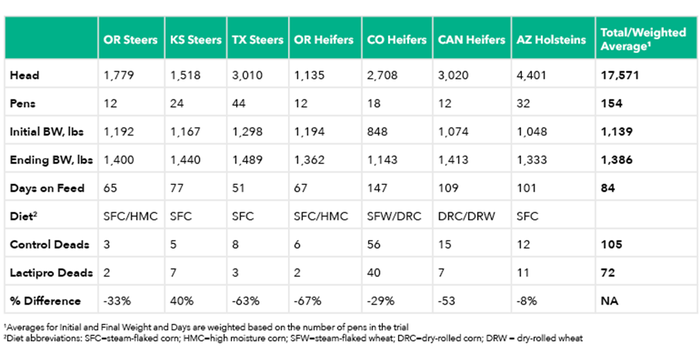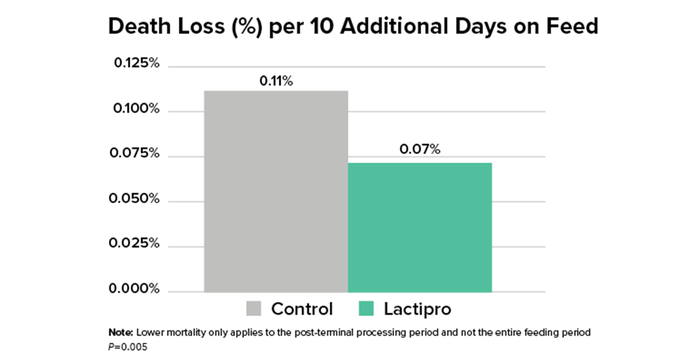Lactipro® Studies Show Reduction in Late-Stage Mortality, Improved ROI
Mortality rate of cattle administered Lactipro® at terminal processing was reduced by 36% and delivered a 2.8:1 ROI
March 1, 2024

Feedyard studies indicate reduction in late-stage mortality, improved ROI with Lactipro®
Feedyard cattle mortality in the late feeding period is costly due to the quantity of feed and labor resources the animal has consumed by this point. Feeding cattle longer also increases the risk of mortality.
Feedyards routinely report overall feeding period mortality; however, few evaluate death loss between terminal processing (reimplant and/or sort) and harvest. Although a singular cause of death is often assigned, the etiology may be multifactorial in nature and difficult to determine. One of the primary causes of late-feeding mortality may be acidotic insults that stem from excessive lactic acid production in the rumen, which can leave animals susceptible to other health challenges.
The rumen bacterium Megasphaera elsdenii (Mega e), contained in Lactipro, has been found to metabolize most of the lactic acid produced in the rumen of cattle fed high-grain diets (Counotte et al., 1981).
This technical summary reports results from a pooled analysis conducted to evaluate differences in post-terminal processing mortality across trials with differing designs. The analysis examined the impact of the use of Lactipro on mortality for each additional 10 days on feed following terminal processing.
Trial summary
Seven large pen feedyard studies (summarized in Table) were conducted to examine the use of Lactipro drench at terminal processing.
Data represents 154 pens and 17,571 head of cattle.
Live animal and carcass performance was measured, and post-terminal processing death loss was assessed in each trial.
This summary only evaluates the effect of Lactipro on post-terminal processing mortality. Other performance measures were not included in this analysis but may lead to additive benefits in addition to mortality reduction.

Photo submitted by Axiota.
Results, economics
The statistical model from the pooled analysis accounted for the effects of paired treatment pens within each trial and estimated deaths per day at risk for the control and Lactipro treatments. This rate was used to calculate death loss percentage for every 10 additional days cattle were fed post-terminal processing (Figure).

Photo submitted by Axiota.
Based on an expert third-party analysis of the data, the mortality rate of cattle administered Lactipro at terminal processing was reduced by 36% compared to control cattle (P = 0.005).
A return on investment for using Lactipro was calculated using the following current assumptions:
180 days on feed, cattle reimplanted at 90 days
135 days on feed, average day of death
In-weight: 750 lbs
Purchase price of cattle: $241.40/cwt.
$25/head processing
Average dry matter intake: 24 lbs/day
Ration cost: $340/ton dry matter; yardage cost: $0.50/day
Lactipro cost
Assuming a 90-day terminal implant window and a dead-animal cost of $2,455, Lactipro administered at terminal processing provided a 2.8:1 return on investment, which does not include additional performance benefits of administering Lactipro at terminal processing that have been demonstrated in commercial feedyard studies.
Click here see the complete study and learn more about using Lactipro in feedyard cattle.
You May Also Like



.png?width=300&auto=webp&quality=80&disable=upscale)
